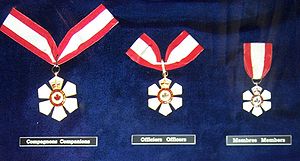- Order of Canada
-
Order of Canada 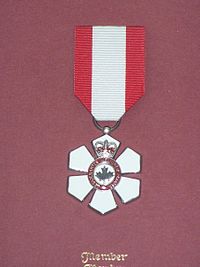
Insignia of a Member of the Order of Canada Awarded by the

Queen of CanadaType National order Motto Desiderantes meliorem patriam Eligibility All living Canadians, except federal and provincial politicians and judges while holding office. Awarded for The highest degree of merit, an outstanding level of talent and service, or an exceptional contribution to Canada and humanity. Status Currently constituted Sovereign Elizabeth II Chancellor David Lloyd Johnston Grades (w/ post-nominals) Companion (CC)
Officer (OC)
Member (CM)Former grades Medal of Service
Medal of CourageStatistics Established 17 April 1967 First induction 1 July 1967 Total inductees 5,604 Precedence Next (higher) Member of the Order of Merit Next (lower) Commander of the Order of Military Merit The Order of Canada (French: Ordre du Canada) is a Canadian national order, admission into which is, within the system of orders, decorations, and medals of Canada, the second highest honour for merit. It comes second only to membership in the Order of Merit, which is within the personal gift of Canada's monarch.
To coincide with the centennial of Canadian Confederation, the three-tiered order was established in 1967 as a fellowship that recognizes the achievement of outstanding merit or distinguished service by Canadians who made a major difference to Canada through lifelong contributions in every field of endeavour, as well as the efforts made by non-Canadians who have made the world better by their actions. Membership is thus accorded to those who exemplify the order's Latin motto, desiderantes meliorem patriam, meaning "they desire a better country."[1] The three tiers of the order are Companion, Officer, and Member.
The order is administered by the Governor General-in-Council on behalf of the Queen of Canada.[2] The monarch, at present Elizabeth II, is Sovereign of the order and the serving governor general, currently David Lloyd Johnston, is its Chancellor and Principal Companion. Appointees into the order are selected by an advisory board and formally inducted by the governor general or the sovereign; as of February 2011, 5,837 people have been appointed to the Order of Canada,[3] including scientists, musicians, politicians, artists, athletes, business people, television and film stars, benefactors, and others; however, some have later resigned or have the honour removed, while others have been controversial. Appointees receive badges and the right to armorial bearings.
Contents
Creation
The process of founding the Order of Canada began in early 1966 and came to a conclusion on 17 April 1967,[4] when the organisation was instituted by Queen Elizabeth II, on the advice of her then Canadian prime minister, Lester B. Pearson, who was assisted with the establishment of the order by John Matheson. The association was then officially launched on 1 July 1967, the 100th anniversary of the formation of Canadian Confederation, with Governor General Roland Michener being the first inductee to the order—to the level of Companion[5]—and on 7 July of the same year, 90 more people were appointed, including Vincent Massey, Louis St. Laurent, Hugh MacLennan, David Bauer, Gabrielle Roy, Donald Creighton, Thérèse Casgrain, Wilder Penfield, Arthur Lismer, and Maurice Richard.[6] During a visit to London, United Kingdom, later in 1967, Michener presented the Queen with her Sovereign's badge for the Order of Canada, which she first wore during a banquet in Yellowknife in July 1970.[7]
From the Order of Canada grew a larger Canadian honours system, thereby reducing the use of British honours (i.e. those administered by the Queen in her British privy council).[8] Among the awards of the Canadian honours system, the Order of Canada comes second only to membership in the Order of Merit,[9] which is within the personal gift of Canada's monarch. By the 1980s, Canada's provinces began to develop their own distinct honours and decorations.[10]
Grades
The Canadian monarch, seen as the fount of honour,[11] is at the apex of the Order of Canada as its Sovereign,[n 1][13] followed by the governor general, who serves as the fellowship's Chancellor.[14] Thereafter follow three grades, which are, in order of precedence: Companion, Officer, and Member, each having accordant post-nominal letters that members are entitled to use;[15] each incumbent governor general is also installed as the Principal Companion for the duration of their time in the viceregal post.[16] Promotions in grade are possible,[17] though this is ordinarily not done within five years of the initial appointment,[n 2][19] and a maximum of five honorary appointments into either of the three grades may be made by the governor general each year.[20] As of 2011[update], there have been eighteen honorary appointments to non-Canadian citizens.[21][22][23]
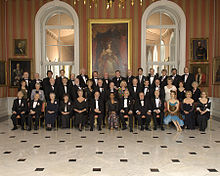 Governor General Michaëlle Jean, then Chancellor and Principal Companion of the Order of Canada, poses with a full group of Order of Canada appointees at the 101st investiture ceremony banquet in the Tent Room of Rideau Hall, 11 April 2008
Governor General Michaëlle Jean, then Chancellor and Principal Companion of the Order of Canada, poses with a full group of Order of Canada appointees at the 101st investiture ceremony banquet in the Tent Room of Rideau Hall, 11 April 2008
There were originally, in effect, only two ranks to the Order of Canada: Companion and the Medal of Service. There was, however, also a third award, the Medal of Courage, meant to recognize acts of gallantry. This latter decoration fell in rank between the other two levels, but was anomalous within the Order of Canada, being a separate award of a different nature rather than a middle grade of the order. Without ever having been awarded, the Medal of Courage was on 1 July 1972 replaced by the autonomous Cross of Valour and, at the same time, the levels of Officer and Member were introduced, with all existing holders of the Medal of Service created as Officers. Lester Pearson's vision of a three-tiered structure to the order was thus fulfilled.[24][25]
Companions of the Order of Canada (post-nominals: CC, in French: Compagnon de l'ordre du Canada) have demonstrated the highest degree of merit to Canada and humanity, on either the national or international scene. Up to 15 Companions are appointed annually, with an imposed limit of 165 living Companions at any given time,[26] save for those appointed in an honorary capacity.[27] The constitution of the Order of Canada also specifies that the reigning monarch, the incumbent governor general and, since 1971,[28] his or her spouse, and former viceroys and viceregal consorts are to be included as Companions of the order,[16][29] though these individuals also do not count towards the 165 person maximum.[27] As of July 2009, there were 170 living Companions.[30] including four honorary.[31] Since 1994,[32] substantive members are the only regular citizens who are empowered to administer the Canadian Oath of Citizenship.[33]
Officers of the Order of Canada (post-nominals: OC, in French: Officier de l'ordre du Canada) have demonstrated an outstanding level of talent and service to Canadians, and up to 64 may be appointed each year, save for those inducted on an honorary basis, with no limit to how many may be living at one time.[34] As of July 2009, there were 1,012 living Officers,[35] including four honorary.[36]
Members of the Order of Canada (post-nominals: CM, in French: Membre de l'ordre du Canada) have made an exceptional contribution to Canada or Canadians at a local or regional level, group, field or activity. As many as 136 Members may be appointed annually, save for those inducted on an honorary basis, and there is no limit on how many Members may be living at one time.[37] As of July 2009, there were 2,037 living Members,[38] including four honorary.[39]
Insignia
Ribbon bar Companion Officer Member 


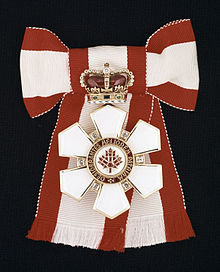 The Sovereign's badge for the Order of Canada, first worn by Queen Elizabeth II on 23 June 1970[40]
The Sovereign's badge for the Order of Canada, first worn by Queen Elizabeth II on 23 June 1970[40]
Upon admission into the Order of Canada, members are gifted various insignia of the organization, all designed by Bruce W. Beatty, who "broke new ground in the design of insignia of Orders within The Queen's realms" and was himself made a member of the order in 1990;[41][42] as of 2004, Beatty has been in attendance at every investiture ceremony since 1967.[43] The badge belonging to the Sovereign consists of a jewelled, 18-carat gold crown of rubies, emeralds, and sapphires,[41] from which is suspended a white, enamelled, hexagonal snowflake design, with six equal leaves and diamonds between each. At the centre is a disc bearing a maple leaf in pavé-laid rubies on a white enamel background, surrounded at its edge by a red enamel ring (annulus) bearing the motto of the order.[44] The Chancellor wears the badge of a Companion and is, upon installation as governor general, granted a livery collar for wear at Order of Canada investiture ceremonies.[45]
The badges for inductees are of a similar design to the sovereign's badge, though without precious stones, and slight differences for each grade. For Companions, the emblem is gilt with a red enamel maple leaf in the central disk; for Officers, it is gilt with a gold maple leaf; and for Members, both the badge itself and the maple leaf are silver. All are topped by a St. Edward's Crown, symbolizing that the order is headed by the sovereign, and the reverse is plain except for the word CANADA.[46] The ribbon is white and bordered in red stripes, similar to the Canadian national flag; the chest ribbon is the same for each grade, save for a metallic maple leaf in the centre, the colour of which matches that on the badge of the grade that the wearer was appointed to. For civilian wear, a lapel pin is worn on the jacket, which is designed as a miniature of the medallion.[n 3]
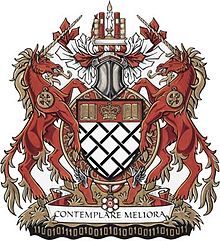 The coat of arms of David Johnston, Governor General of Canada and Chancellor and Principal Companion of the Order of Canada, displaying the order's motto and insignia
The coat of arms of David Johnston, Governor General of Canada and Chancellor and Principal Companion of the Order of Canada, displaying the order's motto and insignia
Wear of the insignia is according to guidelines issued by the Chancellery of Honours, which stipulate that the badges be worn before most other national orders—that is, at the end of an individual's medal bar closest to the centre of the chest or at the wearer's neck—with only the Victoria Cross, the Cross of Valour, and the badge of the Order of Merit permitted to be worn before the badges of the Order of Canada.[9][47] Those in the grades of Companion or Officer may wear their badges on a neck ribbon, while those in the Member group display their insignia suspended by a ribbon from a medal bar on the left chest. Protocol originally followed the British tradition, wherein female appointees wore their Order of Canada emblem on a ribbon bow positioned on the left shoulder. These regulations were altered in 1997, and, with the exception of certain special occasions, women may wear their insignia in either the traditional manner or in the same fashion as the men.[48]
With the patriation in 1988 of oversight of arms to Canada through the Canadian Heraldic Authority,[49] the constitution of the Order of Canada was amended to include the entitlement of all inductees to petition the Chief Herald of Canada for personal armorial bearings,[50] should they not already possess any. Companions may receive supporters, and all members may have the escutcheon (shield) of their arms encircled with a red ribbon bearing the order's motto in gold, and from which is suspended a rendition of the holder's Order of Canada badge.[51] As the Queen is Sovereign of the Order of Canada, she in 1987 approved the augmentation of her royal arms for Canada with the order's ribbon.[52]
Possession and sale
The constitution of the Order of Canada states that the insignia remain property of the Crown,[53] and requires any member of the order to return to the Chancellery their original emblem should they be upgraded within the order to a higher rank.[54] Thus, while badges may be passed down as family heirlooms, or loaned or donated for display in museums, they cannot be sold by any individual other than the monarch with the proper advice and consent of her ministers. Over the decades, however, a number of Order of Canada insignia have been put up for sale, the first being the Companion's badge of Major Coldwell, who was appointed in 1967; his badge was sold at auction in 1981, an act that received criticism from government officials.[55]
In 2007, it was revealed that one of the first ever issued insignia of the Order of Canada, a Medal of Service awarded originally to Quebec historian Gustave Lanctot, was put up for sale via e-mail. Originally, the anonymous auctioneer, who had purchased the decoration for C$45 at an estate sale in Montreal, attempted to sell the insignia on eBay; however, after the bidding reached $15,000, eBay removed the item, citing its policy against the sale of government property, including "any die, seal or stamp provided by, belonging to, or used by a government department, diplomatic or military authority appointed by or acting under the authority of Her Majesty." Rideau Hall stated that selling medals was "highly discouraged," however the owner continued efforts to sell the insignia via the internet.[56]
Eligibility and appointment
Main article: Appointment to the Order of Canada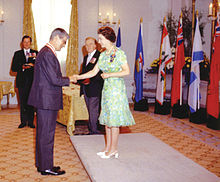 Elizabeth II, Queen of Canada and Sovereign of the Order of Canada, invests Jules Léger as a Companion of the order at Rideau Hall, August 1973
Elizabeth II, Queen of Canada and Sovereign of the Order of Canada, invests Jules Léger as a Companion of the order at Rideau Hall, August 1973
Any of the three levels of the Order of Canada are open to all living Canadian citizens,[57] except all federal and provincial politicians and judges while they hold office. The Order recognizes the achievement of outstanding merit or distinguished service by Canadians who made a major difference to Canada through lifelong contributions in every field of endeavour, as well as the efforts made by non-Canadians who have made the world better by their actions. Membership is thus accorded to those who exemplify the order's Latin motto, taken from Hebrews 11:16 of the Bible, desiderantes meliorem patriam, meaning "they desire a better country."[58] Each of the six to eight hundred nominations submitted each year,[59] by any person or organization, is received by the order's Advisory Council, which, along with the governor general, makes the final choice of new inductees, typically by consensus rather than a vote;[59] a process that, when conceived, was the first of its kind in the world.[59] Appointees are then accepted into the organization at an investiture ceremony typically conducted by the governor general at Rideau Hall, though the Queen or another viceroy may perform the task and the ceremony may take place in other locations. Since the 1991 investiture of Ted Rogers, Order of Canada instalment ceremonies have been broadcast on various television channels and the Internet; recipients are given a complimentary copy of their investiture ceremony from Rogers Cable.[60]
Advisory Council
The task of the Advisory Council is to evaluate the nominations of potential inductees, decide if the candidates are worthy enough to be accepted into the order, and make recommendations to the governor general, who appoints the new members. The council is chaired by the Chief Justice of Canada, and includes the Clerk of the Queen's Privy Council, the Deputy Minister of Canadian Heritage, the Chair of the Canada Council for the Arts, the President of the Royal Society of Canada, the Chair of the Association of Universities and Colleges of Canada, and five members of the order who sit on the council for a three year period. If a nomination involves a non-Canadian citizen, the Deputy Minister of Foreign Affairs is invited by the Advisory Council to offer evaluation.[61] Decisions of the council and/or new appointments to and/or dismissals from the Order of Canada are announced to the Canada Gazette.[62]
The current (as of October 2011) members of the Advisory Council are:[61]
- Beverley McLachlin PC, Chief Justice of Canada (Chair)
- Michel Belley, Chair, Association of Universities and Colleges of Canada
- Roberta L. Jamieson CM, Ontario representative (President and CEO of the National Aboriginal Achievement Foundation)
- Aldéa Landry PC CM QC, Atlantic representative
- Daniel Jean, Deputy Minister, Canadian Heritage
- Roderick A. Macdonald, President-Elect, Royal Society of Canada: The Academies of Arts, Humanities and Sciences of Canada
- Lalita Malhotra CM SOM MBBS FRCOG, Prairies representative
- Martha Piper OC OBC, Western representative
- Joseph L. Rotman OC, President, Canada Council for the Arts
- Joseph A. Rouleau CM GOQ, Quebec representative
- Wayne G. Wouters, Clerk of the Privy Council and Secretary to the Cabinet
Refusal
While few have declined entry into the Order of Canada, it is not unheard of: as of 1997, 1.5 percent of offered appointments to the order have been refused.[63] The identities of those individuals who have declined induction since the 1970s are kept confidential, so the full list is not publicly known. Some, however, have spoken openly about their decisions, including Robert Weaver, who stated that he was critical of the "three-tier" nature of the order;[64] Claude Ryan and Morley Callaghan, who both declined the honour in 1967; Mordecai Richler, who twice declined; and Marcel Dubé, Roger Lemelin, and Glenn Gould, who all declined in 1970.[65] However, all the above individuals, save for Gould and Weaver, later did accept appointment into the order. Others have rejected appointment on the basis of being supporters of the Quebec sovereignty movement—such as Luc-André Godbout, Rina Lasnier, and Geneviève Bujold[65]—while Alice Parizeau, another supporter of Quebec sovereignty, was criticized for accepting entry into the order, in spite of her beliefs.[66]
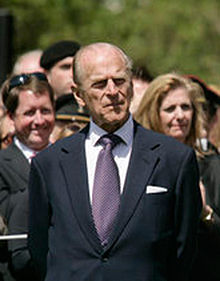 Prince Philip, Duke of Edinburgh; declined an honorary appointment to the Order of Canada, feeling the offer implied he was a foreigner to Canada
Prince Philip, Duke of Edinburgh; declined an honorary appointment to the Order of Canada, feeling the offer implied he was a foreigner to Canada
Others decline out of modesty, such as Victoria Cross recipient Cecil Meritt, who cited the fact that he already held Canada's highest decoration as a reason not to be admitted to the Order of Canada.[65] Prince Philip, Duke of Edinburgh, was in 1982 offered appointment to the order as an honorary Companion; however, he refused on the grounds that, as the consort of the Queen, he was a Canadian and thus entitled to a substantive appointment.[67][68] In 1993, the Advisory Council proposed an amendment to the constitution of the Order of Canada, making the sovereign's spouse automatically a Companion, but Prince Philip again refused, stating that if he was to be appointed, it should be on his merits. Congruent with these arguments, he in 1988 accepted without issue a substantive induction as a Companion of the Order of Australia.[69] Former Premier of Newfoundland Joey Smallwood declined appointment as a Companion because he felt that, as a Father of Confederation, he deserved a knighthood.[65] Smallwood was never knighted and later accepted induction as a Companion.[70]
Resignation and removal
Main article: Removal from the Order of CanadaResignations from the order can take place only through the prescribed channels, which include the member submitting to the Secretary General of the Order of Canada a letter notifying the chancellery of his or her desire to terminate their membership, and only with the governor general's approval can the resignation take effect.[71] On 1 June 2009, the governor general accepted the resignations of astronomer and inventor René Racine, pianist Jacqueline Richard, and Cardinal Jean-Claude Turcotte;[72][73] on 11 January 2010, did the same for Renato Giuseppe Bosisio, an engineering professor, and Father Lucien Larré;[74] and on 19 April 2010 for Frank Chauvin.[75] It was also reported that other constituents of the Order of Canada had, in reaction to Henry Morgentaler's induction into their ranks, indicated that they would return or had returned their emblems in protest,[76][77] including organizations such as the Missionary Oblates of Mary Immaculate and Madonna House Apostolate doing so on behalf of deceased former members.[76][78]
Members may be removed from the order if the Advisory Council feels their actions have brought the society into disrepute. In order for this to be done, the council must agree to take action and then send a letter to the person both telling of the group's decision and requesting a response. Anyone removed from the order is required to return their insignia. As of 2010, four people have been removed from the Order of Canada: Alan Eagleson, who was dismissed after being jailed for fraud in 1998;[79] David Ahenakew, who faced calls for his removal due to anti-Semitic comments he made in 2002;[80] T. Sher Singh, after the Law Society of Upper Canada found him guilty of professional misconduct and revoked his licence to practise law;[81] and Steve Fonyo, due to "his multiple criminal convictions, for which there are no outstanding appeals."[82][83]
Controversial appointments
The advisory board attempts to remain apolitical and pragmatic in its approach to selecting new members of the Order of Canada, generally operating without input from ministers of the Crown; political interference has occurred only once, when in 1978 Paul Desmarais's investiture was delayed for six months by Prime Minister Pierre Trudeau.[59] However, some of the committee's selections have caused controversy. For instance, the admission in 2001 of sex educator Sue Johanson, host of the long-running Sunday Night Sex Show, as a Member stirred controversy among Canada's Christian organizations, as Johanson had taught teenagers methods of safe sex alongside abstinence.[84] Similarly, the acceptance of birth control advocate Elizabeth Bagshaw and gay rights campaigner Brent Hawkes also incited debate.[59]
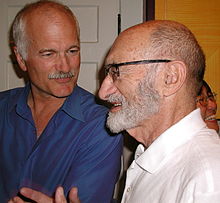 Henry Morgentaler (centre), with Jack Layton (left) and Olivia Chow (behind); Morgentaler's appointment was one of the most controversial in the history of the Order of Canada
Henry Morgentaler (centre), with Jack Layton (left) and Olivia Chow (behind); Morgentaler's appointment was one of the most controversial in the history of the Order of Canada
Abortion activist Henry Morgentaler's appointment to the order on 1 July 2008 not only marked the first time the Advisory Council had not been unanimous on its decision, but also proved to be one of the most controversial appointments in the order's history,[59][62] drawing both praise from abortion rights groups and the ire of Members of Parliament, anti-abortion groups, and religious leaders.[n 4][86] The latter organized protests outside of Rideau Hall on 9 July, while compatriots did the same in front of Government House in St. John's, Newfoundland and Labrador, the official residence of that province's lieutenant governor.[87] One former police detective, Frank Chauvin, along with a Catholic anti-abortion activist, filed suit against the Order of Canada Advisory Council, demanding that the minutes of the meeting relating to Morgentaler be made public.[88] The appointment of Morgentaler prompted former Liberal Member of Parliament Clifford Lincoln to write that the workings of the Advisory Council were "mysterious", citing what he theorised to be inbuilt partiality and conflict of interest as reason why Margaret Somerville, whom Lincoln had twice nominated to the Advisory Council, was turned down for appointment, yet Morgentaler was accepted.[89] Journalist Henry Aubin in the Montreal Gazette opined that the council's rejection of Somerville, her personal opposition to same-sex marriage, and the acceptance of Brent Hawkes, Jane Vance Rule, and Jean Chrétien, all regarded as supporting same-sex unions, as well as the appointment of a controversial figure such as Morgentaler, were all signs that the Advisory Council operated with partisan bias.[90] Aubin also pointed to the presence on the council of members of the Royal Society of Canada, an organization into which Somerville was received.[90]
Proposed amendments
At a 2006 conference on Commonwealth honours, Christopher McCreery, an expert on Canada's honours, raised the concern that the three grades of the Order of Canada were insufficient to recognize the nation's very best; one suggestion was to add two more levels to the order, equivalent to knighthoods in British orders. The order of precedence also came under scrutiny, particularly the anomaly that all three grades of the Order of Canada supersede the top levels of each of the other orders (except the Order of Merit), contrary to international practice.[91]
In June 2010, McCreery suggested reforms to the Order of Canada that would avert the awkwardness around appointing those in Canada's royal family as full members of the order: He theorised that the Queen, as the order's Sovereign, could simply appoint, on ministerial advice, anyone as an extra member, or the monarch could issue an ordinance allowing for her relations to be made regular members when approved. Similarly, McCreery proposed that a new division of the order could be established specifically for governors general, their spouses, and members of the Royal Family.[68]
Additional honours
At certain periods, holders of the order were presented with other awards, usually commemorative medals. Thus far, one commemorative medal has been given automatically to every living member of the Order of Canada: the Queen Elizabeth II Silver Jubilee Medal in 1977.[92]
Notes
- ^ In royal proclamations issued by the Queen or in her name, the order is thus referred to as "Our Order of Canada".[12]
- ^ For example, Denys Arcand was created as an Officer of the Order of Canada on 29 December 1986 and was promoted to Companion on 29 October 2004.[18]
- ^ This photo of Roméo Dallaire illustrates the wearing of the lapel pin.
- ^ The Catholic Archbishop of Toronto, Thomas Collins, said the honour had been "debased" by admitting someone who fought for the legalization of abortion, while, conversely, Joyce Arthur of the Abortion Rights Coalition of Canada supported the appointment of Morgentaler, calling the decision "overdue."[85]
References
- ^ Department of Canadian Heritage, Ceremonial and Canadian Symbols Promotion > The arms of Canada > The Proclamation, http://www.pch.gc.ca/pgm/ceem-cced/symbl/arm1-eng.cfm, retrieved 24 July 2009
- ^ Department of National Defence 2009, p. 1
- ^ Office of the Governor General of Canada 2011
- ^ McCreery 2005, p. xiii
- ^ Office of the Governor General of Canada 2011, Roland Michener, P.C., C.C., C.M.M., C.D., LL.D.
- ^ Clarkson, Adrienne (30 October 2004), "Her Excellency the Right Honourable Adrienne Clarkson: Speech on the Occasion of the Order of Canada Investiture", in Office of the Governor General of Canada, Media > Speeches, Queen's Printer for Canada, 15 December 2004, http://archive.gg.ca/media/doc.asp?lang=e&DocID=4337
- ^ The Royal Household (2006), "Mailbox", Royal Insight Magazine (Queen's Printer) (April 2006): 3, archived from the original on 2008-05-16, http://web.archive.org/web/20080516000637/http://www.royal.gov.uk/output/page5218.asp, retrieved 6 March 2007
- ^ McCreery 2005, p. 228
- ^ a b Government of Canada (8 December 2010), "Order of Merit (O.M.) Order", Canada Gazette (Queen's Printer for Canada) 144 (25), SI/2010-88, http://www.gazette.gc.ca/rp-pr/p2/2010/2010-12-08/html/si-tr88-eng.html, retrieved 10 December 2010
- ^ Department of Canadian Heritage, National and provincial honours, Queen's Printer for Canada, http://pch.gc.ca/pgm/ceem-cced/symbl/101/123-eng.cfm, retrieved 24 October 2011
- ^ Royal Canadian Mounted Police, Honours and Recognition Programs > Canadian National Honours, Queen's Printer for Canada, http://www.rcmp-grc.gc.ca/hon/nat-honour-honneur/index-eng.htm, retrieved 20 May 2009
- ^ Elizabeth II (28 March 2011), "Proclamation Summoning Parliament to Meet on May 30, 2011", Canada Gazette (Queen's Printer for Canada) 145 (1), http://www.gazette.gc.ca/rp-pr/p2/2011/2011-03-28-x1/html/si-tr34-eng.html, retrieved 14 September 2011
- ^ Office of the Governor General of Canada, Honours > National Orders > Order of Canada, Queen's Printer for Canada, http://archive.gg.ca/honours/nat-ord/oc/index_e.0708071500.asp, retrieved 2 March 2010
- ^ Elizabeth II 2004
- ^ Elizabeth II 2004, 21.1.d
- ^ a b Elizabeth II 2004, 12.1
- ^ Elizabeth II 2004, 24.2
- ^ Office of the Governor General of Canada Search Order of Canada Membership List, Georges-Henri Denys Arcand, C.C., C.Q.
- ^ Department of National Defence 2009, p. 2C-2
- ^ Elizabeth II 2004, 10.2
- ^ Office of the Governor General of Canada. "It's an Honour". Queen's Printer for Canada. http://www.gg.ca/honours.aspx?q=&t=12&p=&c=&pg=1&types=12&advoocHonorary=1. Retrieved 9 November 2011.
- ^ McCreery 2005, pp. 223-224
- ^ Office of the Governor General of Canada, It's an Honour, Queen's Printer for Canada, http://www.gg.ca/honour.aspx?id=8141&t=12&ln=Gehry, retrieved 9 November 2011
- ^ Lochnan, Carl, "Culture > Awards > Order of Canada", in Marsh, James H, The Canadian Encyclopedia, Historica Foundation of Canada, http://www.thecanadianencyclopedia.com/index.cfm?PgNm=TCE&Params=A1ARTA0005969, retrieved 24 July 2009
- ^ McCreery 2005, pp. 126, 149, 166
- ^ Elizabeth II 2004, 16
- ^ a b Elizabeth II 2004, 13
- ^ McCreery 2005, p. 156
- ^ Elizabeth II 2004, 12.2
- ^ Office of the Governor General of Canada Search Order of Canada Membership List, Honour Received: Companion (CC), Field: Living
- ^ Office of the Governor General of Canada Search Order of Canada Membership List, Honour Received: Companion (CC) Honorary, Field: Living
- ^ Office of the Governor General of Canada (2008), "Did You Know?", Celebrating Excellence! Winter 2008: 3, http://gg.ca/honours/pdf/OCnewsWinter2008.pdf, retrieved 24 July 2009
- ^ Institute for Canadian Citizenship (17 October 2007), Welcoming Canadians: Planning community citizenship ceremonies, Institute for Canadian Citizenship, p. 14, http://www.icc-icc.ca/en/assets/pdf/CeremonyHandbook.pdf, retrieved 1 January 2010
- ^ Elizabeth II 2004, 17
- ^ Office of the Governor General of Canada Search Order of Canada Membership List, Honour Received: Officer (OC), Field: Living
- ^ Office of the Governor General of Canada Search Order of Canada Membership List, Honour Received: Officer (OC) Honorary, Field: Living
- ^ Elizabeth II 2004, 19
- ^ Office of the Governor General of Canada Search Order of Canada Membership List, Honour Received: Member (CM), Field: Living
- ^ Office of the Governor General of Canada Search Order of Canada Membership List, Honour Received: Member (CM) Honorary, Field: Living
- ^ Library and Archives Canada, Sov. Badge of Order of Canada, Queen's Printer for Canada, http://collectionscanada.gc.ca/ourl/res.php?url_ver=Z39.88-2004&url_tim=2010-03-03T00%3A14%3A31Z&url_ctx_fmt=info%3Aofi%2Ffmt%3Akev%3Amtx%3Actx&rft_dat=3603370&rfr_id=info%3Asid%2Fcollectionscanada.gc.ca%3Apam, retrieved 30 July 2009
- ^ a b The Royal Collection, e-Gallery > Exhibitions > Queen & Commonwealth > Orders > Order of Canada, Sovereign's Badge, Queen's Printer, http://www.royalcollection.org.uk/microsites/queenandcommonwealth/MicroObject.asp?row=13&themeid=453&item=13, retrieved 26 July 2009
- ^ Office of the Governor General of Canada 2011, Bruce W. Beatty, C.M., C.D.
- ^ MacMillan, Margaret; Harris, Marjorie; Desjardins, Anne L (2004), Canada's House: Rideau Hall and the invention of a Canadian home, A.A. Knopf Canada with Otherwise Editions, p. 58, ISBN 0-676-97675-1
- ^ Library and Archives Canada, Sovereign Badge of The Order of Canada, Queen's Printer for Canada, MIKAN 3601802, http://collectionscanada.gc.ca/pam_archives/index.php?fuseaction=genitem.displayEcopies&lang=eng&rec_nbr=3601802&rec_nbr_list=3603370,3601802&title=Sovereign+Badge+of+The+Order+of+Canada.+&ecopy=e000945229-v6&back_url=%28%29, retrieved 24 October 2011
- ^ "Adrienne Clarkson Installed as Governor General", Canadian Monarchist News (Monarchist League of Canada) Autumn 1999 (3), 1999, archived from the original on 31 May 2010, http://web.archive.org/web/20100531003841/http://www.monarchist.ca/cmn/1999/installed.htm, retrieved 29 May 2009
- ^ Robertson, Megan C, C > Canada > Orders, Decorations and Medals of Canada > Order of Canada, Medals of the World, http://www.medals.org.uk/canada/canada001.htm, retrieved 26 July 2009
- ^ Chancellery of Honours 2005, p. 7
- ^ Chancellery of Honours 2005, p. 2
- ^ Office of the Governor General of Canada, Heraldry Today, Queen's Printer for Canada, http://www.gg.ca/document.aspx?id=2, retrieved 2 March 2010
- ^ Elizabeth II 2004, 21.1.b
- ^ Elizabeth II 2004, 21.1.c
- ^ Parliamentary Debates, House of Commons, 5 December 1995, columns 1410–1415.
- ^ Elizabeth II 2004, 23.1
- ^ Elizabeth II 2004, 24.3.b
- ^ McCreery 2005, p. 197
- ^ Canadian Press (6 January 2007), Order of Cda. medal auction to proceed by e-mail, CTV, http://www.ctv.ca/servlet/ArticleNews/story/CTVNews/20070106/medal_auction_070106/20070106?hub=Canada, retrieved 16 May 2008
- ^ Elizabeth II 2004, 9.1
- ^ Department of Canadian Heritage, Ceremonial and Canadian Symbols Promotion > The arms of Canada > The Proclamation, http://www.pch.gc.ca/pgm/ceem-cced/symbl/arm1-eng.cfm, retrieved 24 July 2009
- ^ a b c d e f McCreery, Christopher (31 March 2009), Interview, in Editorial Board, "Controversy and the Order of Canada", The Globe and Mail, http://www.theglobeandmail.com/news/opinions/controversy-and-the-order-of-canada/article695978/
- ^ Order of Canada Investiture Ceremony, 12 December 2008, Rogers Media, 2008, http://www.cpac.ca/forms/index.asp?dsp=template&act=view3&pagetype=vod&lang=e&clipID=2224
- ^ a b Office of the Governor General, The Advisory Council for the Order of Canada, Queen's Printer for Canada, http://archive.gg.ca/honours/nat-ord/oc/oc-nrp_e.asp, retrieved 24 October 2011
- ^ a b McCreery 2010, p. 6
- ^ McCreery 2005, p. 209
- ^ On This Day > Jan. 2, 1988 > Did You Know?, CBC, http://archives.cbc.ca/on_this_day/01/02/, retrieved 22 June 2008
- ^ a b c d McCreery 2005, p. 210
- ^ (in French) Alice Parizeau, d'espoir et de liberté, CBC, http://archives.radio-canada.ca/c_est_arrive_le/09/30/, retrieved 24 October 2011
- ^ Bell, Lynne; Bousfield, Artuhur; Bousfield, Gary (2007), Queen and Consort, Dundurn Press, p. 161, ISBN 978-1-55002-725-9
- ^ a b McCreery 2010, p. 5
- ^ Valpy, Michael (28 September 2002), "The Fresh Prince", The Globe and Mail, archived from the original on 2 December 2005, http://web.archive.org/web/20051202235324/http://www.theglobeandmail.com/backgrounder/queen/stories/related02.html, retrieved 27 July 2009
- ^ McCreery 2005, p. 168
- ^ Elizabeth II 2004, 25.b
- ^ Office of the Governor General of Canada (1 June 2009), Media > News Releases and Messages > Resignations from the Order of Canada, Queen's Printer for Canada, http://archive.gg.ca/media/doc.asp?lang=e&DocID=5761, retrieved 1 June 2009
- ^ Public Works and Government Services Canada (30 May 2009), "Government House > Terminations of Appointment to the Order of Canada", Canada Gazette (Queen's Printer for Canada) 143 (22): 1574, http://gazette.gc.ca/rp-pr/p1/2009/2009-05-30/pdf/g1-14322.pdf, retrieved 6 November 2009
- ^ [Resignations from the Order of Canada], Queen's Printer for Canada, 11 January 2010, http://gg.ca/document.aspx?id=13477, retrieved 11 January 2010
- ^ "Resignation from the Order of Canada" (Press release). Queen's Printer for Canada. 19 April 2010. http://www.gg.ca/document.aspx?id=13597. Retrieved 23 April 2010.
- ^ a b Catholic group handing in Order of Canada over Morgentaler, CBC, 8 July 2008, http://www.cbc.ca/canada/story/2008/07/08/morgentaler-order.html, retrieved 8 July 2008
- ^ Former lieutenant-governor returns Order of Canada in protest, CBC, 9 July 2008, http://www.cbc.ca/canada/new-brunswick/story/2008/07/09/nb-finn.html, retrieved 9 July 2008
- ^ Chin, Joseph (8 December 2008), Church returns Order of Canada medals, Mississauga, http://www.mississauga.com/article/21826, retrieved 13 April 2009
- ^ Sports > Business of Sports > The Rise and Fall of Alan Eagleson, CBC, http://archives.cbc.ca/IDCC-1-41-1493-10073/sports/alan_eagleson/, retrieved 28 July 2009
- ^ Quebec Cree Chief wants Ahenakew to lose Order of Canada, CBC, 17 December 2002, archived from the original on 2005-10-28, http://web.archive.org/web/20051028125320/http://montreal.cbc.ca/regional/servlet/View?filename=qc_mosesreax20021217, retrieved 28 July 2009
- ^ Office of the Governor General of Canada (6 April 2009), Revocation of Order of Canada membership of T. Sher Singh, Queen's Printer for Canada, http://archive.gg.ca/media/doc.asp?lang=e&DocID=5685, retrieved 28 July 2009
- ^ Office of the Governor General of Canada (25 January 2010), Revocation of the Order of Canada Membership of Stephen Fonyo, Jr, Queen's Printer for Canada, http://www.gg.ca/document.aspx?id=13497, retrieved 25 January 2010
- ^ Fonyo loses Order of Canada, CBC, 25 January 2010, http://www.cbc.ca/canada/montreal/story/2010/01/25/fonyo-orderofcanada.html, retrieved 25 January 2010
- ^ Editorial Board (3 July 2008), "A deserving recipient", Toronto Star, http://www.thestar.com/comment/article/453124, retrieved 5 July 2008
- ^ Morgentaler proud to receive Order of Cda, says Cda set global example, The Canadian Press, 3 July 2008, http://www.breitbart.com/article.php?id=cp_g4gaqoptm26&show_article=1, retrieved 24 October 2011
- ^ Wagonner, Tim (2 July 2008), "Pro-Life Groups Horrified by Morgentaler's Appointment to the Order of Canada", LifeSiteNews, http://www.lifesitenews.com/ldn/2008/jul/08070208.html, retrieved 5 July 2008
- ^ Former N.B. lieutenant-governor to return Order of Canada in protest, CBC, 9 July 2008, http://www.cbc.ca/canada/new-brunswick/story/2008/07/09/nb-finn.html, retrieved 9 July 2008
- ^ Sonski, Peter (27 July 2008), "Exclusive: Abortionist's Order of Canada Appointment Brings Law Suit", Headline Bistro (Knights of Columbus), http://www.headlinebistro.com/hb/en/news/world/Morgentaler_lawsuit.html, retrieved 27 July 2009
- ^ Lincoln, Clifford (15 July 2008), "Should our top judge be choosing recipients of the Order of Canada?", Montreal Gazette, http://www.canada.com/montrealgazette/news/editorial/story.html?id=478b56b1-633a-4aec-a9cc-99ff23d39e93, retrieved 3 October 2009
- ^ a b Aubin, Henry (8 July 2008), "McGill ethicist refused OC because she was 'too controversial'", Montreal Gazette, http://www.canada.com/montrealgazette/features/viewpoints/story.html?id=62cda378-0d93-4a8b-8d88-010af82ffe62, retrieved 3 October 2009
- ^ Jackson, Michael D (2007), "Honours of the Crown", Canadian Monarchist News (Monarchist League of Canada) Summer 2007 (26): 10–11, archived from the original on 25 June 2008, http://web.archive.org/web/20080625225416/http://www.monarchist.ca/cmn/2007/Summer_2007_CMN.pdf, retrieved 11 November 2009
- ^ Veterans Affairs Canada, Canada Remembers > Records & Collections > Canadian Orders, Medals and Decorations > Canadian Military Medals and Decorations > Commemorative Medals > Queen Elizabeth II Jubilee Medal (1977), Queen's Printer for Canada, http://www.veterans.gc.ca/eng/collections/cmdp/mainmenu/group10/qeiijm, retrieved 24 October 2011
Citations
- Chancellery of Honours (September 2005), Wearing of Orders, Decorations and Medals, Queen's Printer for Canada, http://gg.ca/honours/pdf/wearing_e.pdf, retrieved 25 July 2009
- Department of National Defence (26 March 2009), "18", Queen's Regulations and Orders for the Canadian Forces, 1, Queen's Printer for Canada, 18.01, http://www.admfincs-smafinsm.forces.gc.ca/qro-orf/vol-01/hv-vh/cha-18/doc/03101986-04062008.pdf, retrieved 24 July 2009
- Elizabeth II (2004), The Constitution of the Order of Canada, 3, Queen's Printer for Canada, http://archive.gg.ca/honours/nat-ord/oc/oc-con_e.asp, retrieved 2 March 2010
- McCreery, Christopher (2005), The Order of Canada: Its Origins, History and Development, University of Toronto Press, ISBN 978-0-8020-3940-8
- McCreery, Christopher (2010), The Crown and Honours: Getting it Right, Queen's University Press, http://www.queensu.ca/iigr/conf/Arch/2010/ConferenceOnTheCrown/CrownConferencePapers/The_Crown_and_Honours.pdf, retrieved 24 October 2011
- Office of the Governor General of Canada (2011), Honours > Order of Canada > Search: Order of Canada Membership List > Honour Received: All; Field: Both Living and Deceased, Queen's Printer for Canada, http://archive.gg.ca/honours/search-recherche/index_e.asp?results=1&Firstname=&Middlename=&Lastname=&City=&Province=&TypeID=orc&Honours=&Field=&deceased=&AwardStart=&AwardEnd=&InvestStart=&InvestEnd=&npp=25, retrieved 24 July 2009
Further reading
- Blatherwick, Francis John (2003), Canadian Orders, Decorations and Medals, Unitrade Press, ISBN 978-0-91980-1103
- McCreery, Christopher (2005), The Canadian Honours System, Dundurn Press, ISBN 978-1-55002-554-5
- McCreery, Christopher (2008), On Her Majesty's Service; Royal Honours and Recognition in Canada, Dundurn Press, ISBN 978-1-55002-742-6
- The Register of Canadian Honours, Canadian Almanac and Directory, 1991, ISBN 1-895021-01-4
External links
- Governor General's Order of Canada site
- Canadian Orders, Decorations and Military Honours
- CBC Archives: First Order of Canada appointments announced (audio)
- CBC Archives: 'They desire a better country' (video)
- Medals.org: Order of Canada
 Orders, Decorations, and Medals of Canada
Orders, Decorations, and Medals of CanadaAwards of valour National orders Provincial orders Other Decorations and medals Categories:- Awards established in 1967
- 1967 in Canada
- Order of Canada
- Canadian heraldry
Wikimedia Foundation. 2010.

